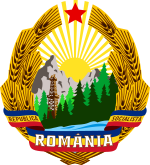Bărăgan deportations
This article includes a list of general references, but it lacks sufficient corresponding inline citations. (May 2018) |

| Part of a series on the |
| Socialist Republic of Romania |
|---|
 |
The Bărăgan deportations (Romanian: Deportările în Bărăgan) were a large-scale action of penal transportation, undertaken during the 1950s by the Romanian Communist regime. Their aim was to forcibly relocate individuals who lived within approximately 25 km (15 miles) of the Yugoslav border (in present-day Timiș, Caraș-Severin, and Mehedinți counties) to the Bărăgan Plain. The deportees were allowed to return after 1956.
Reasons
[edit]After relations deteriorated between Romania and Yugoslavia, which was excluded from the Cominform in 1948, the border between the two states became a sensitive area for Bucharest (see Informbiro period). The ethnic minorities present there, especially in the Banat, were considered "elements with a heightened risk factor". Following the Soviet model of the Gulag, on March 15, 1951 the Ministry of Interior of the Romanian People's Republic issued the following decree:
The Ministry of Interior will be able, through a decision, to order the removal from population centres of any persons whose presence in those centres is unjustified, as well as the removal of those from any locality who, through their actions before the working people, endanger the construction of socialism in the Romanian People's Republic. For those in question obligatory residences can be set up in any locality.
The decree created favourable conditions for the implementation of the previously-planned deportations. This was to be the second mass deportation following the overthrow of Ion Antonescu, after the January 1945 deportation of over 30,000 ethnic Germans to the Soviet Union, during the closing stages of World War II (the deportees gradually returned between 1945 and 1952). In contrast to the first deportation, this time, the destination was the Bărăgan Plain, an underdeveloped, sparsely populated area. In a sense, the operation also served as a means of colonizing the region.
The plans allegedly involved, as was later discovered in a document written in Timișoara in 1956, the "purification of the Banat": the ethnic cleansing of Banat Germans, Banat Serbs, Banat Croats[1] and Banat Bulgarians.[citation needed] Additionally, the plans involved the expulsion of members of several social categories considered dangerous by the Romanian Communist Party. Among the targets were farmers with large holdings (known as chiaburi, and roughly equivalent to the Soviet kulaks), wealthy landowners, industrialists, innkeepers and restaurant owners, Bessarabian and Macedonian refugees, former members of the Wehrmacht, foreign citizens, relatives of the refugees, Titoist sympathizers, wartime collaborators of Nazi Germany (see Romania during World War II), Romanian Army employees, fired civil servants, relatives of counter-revolutionaries and all who had supported them, political and civic rights activists, former businessmen with Western ties, and leaders of the ethnic German community.
Events
[edit]

During the night of June 18, 1951, the third-largest mass deportation in modern Romanian history took place, surpassed only by the World War II deportation of Jews to Transnistria (considered collectively, and ended with massive extermination), and the January 1945 deportation of ethnic Germans from Romania. 40,000 people were taken from their homes and deported to the Bărăgan. These included Romanians, Germans (mostly Banat Swabians), Serbs, Bulgarians, Banat Czechs, and some Ukrainian refugees from Bessarabia and Northern Bukovina, Aromanians, rich peasants, former landlords, bourgeoisie, convicted criminals and Nazi collaborators. Of the roughly 40,000 people who were deported from Banat, 629 people died in the Bărăgan Plain.[2]
The deportees were taken under military guard and left to build houses of mud or adobe on their own in eighteen localities. In 1956, a change in government policy meant that the majority of deportees returned home, but some chose to stay permanently in the Bărăgan Plain.
References
[edit]- ^ Glasnik HDZ, 1991
- ^ Miroiu, Andrei (2016). Romanian Counterinsurgency and its Global Context, 1944-1962. Springer. p. 79. ISBN 978-3-319-32379-4.
- Elena Spijavca, Munci și zile în Bărăgan (Works and Days on the Bărăgan), 2004, Editura Fundația Academică Civică, ISBN 973-8214-23-8
- Rafael Mirciov, Lagărul deportării – Pagini din lagărul Bărăganului (The Deportations Camps – Pages from the Bărăgan Camp)
- Silvestru Ștevin, Desculț prin propriul destin (Barefoot through My Own Destiny), Editura Mirton, Timișoara, 2002
- Silviu Sarafolean, Deportații în Bărăgan 1951–1956 (The Bărăgan Deportations, 1951–1956)
- Viorel Marineasa, Daniel Vighi, Rusalii ’51 – fragmente din deportarea în Bărăgan (Pentecost '51 – Fragments from the Bărăgan Deportations)
- Viorel Marineasa, Daniel Vighi, Valentin Sămînță, Deportarea în Bărăgan – Destine, documente, reportaje (The Bărăgan Deportations – Destinies, Documents, Reportages)
External links
[edit]- (in Romanian) Association of Former Bărăgan Deportees – Timișoara
- "Sighet Museum: Room 47 – Deportations to Bărăgan". www.memorialsighet.ro. The Memorial of the Victims of Communism and of the Resistance. 11 October 2015. Retrieved July 22, 2020.
- "Deportați in Bărăgan" [Deported to the Bărăgan]. Ziua (in Romanian). Retrieved July 22, 2020.
- Smaranda Vultur (June 23, 2006). "Din istoria unei memorii, Bărăgan 1951–1956" [From the History of a Memory, Bărăgan 1951–1956]. Revista 22 (in Romanian). Archived from the original on 2006-07-19. Retrieved July 22, 2020.
- Gerhard Binder (June 2005). "De sărbătoarea Rusaliilor s-a împlinit mai bine de jumătate de veac de la pribegia în Bărăgan" [It has been more than half a century since the exile in the Bărăgan] (in Romanian). Agenda – Timișoara. Archived from the original on 2006-02-06. Retrieved July 22, 2020.
- ""Igienizarea" din Banat" [The "Purification" of the Banat]. Evenimentul Zilei (in Romanian). February 25, 2006. Archived from the original on 2007-03-13. Retrieved July 22, 2020.
- (in Romanian) Map of the Romanian Gulag (pdf)
- (in English) Donauschwaben Villages Helping Hands – Deportation to the Bărăgan
- Walther Konschitzky; Peter-Dietmar Leber; Walter Wolf (2001). "Deported to the Bărăgan 1951–1956". www.dvhh.org. Munchen: Haus des Deutschen Ostens. Retrieved July 22, 2020.
